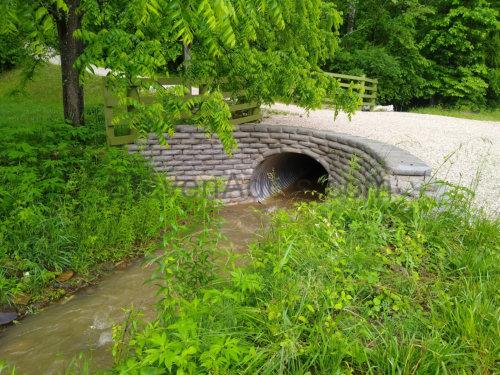Hi. Here I will share hands-on experience with concrete bag retaining walls.
When it comes to building retaining walls that are cost effective, simple, well made, and last the test of time, home owners may want to consider a properly built concrete bag wall.
When it comes to building retaining walls that are cost effective, simple, well made, and last the test of time, home owners may want to consider a properly built concrete bag wall.

Do concrete bag walls last and hold up over time?
I have actually built multiple walls over the last several years and they are performing well to this day. This is not a new method and goes back many years in the past. Concrete bag walls built 40 years ago or more are standing to this day and are still performing their task of directing water and soil retention.
Are concrete bags cost effective for building a retaining wall?
One 70 foot wall cost me less than $1,000 at the time. Using a contractor to build my wall would have cost 10 to 20 times this price. This is a massive savings if you are able to do this type of work and have the time to do it.
Also, 50lb concrete bags usually cost less than castle block and other block types. For instance, when I built the culvert wing wall several years ago, a 50lb bag cost only $1.83 per bag with my discounts from Lowe’s. Also consider the cost of buying wood to make forms for doing a concrete pour compared to simply stacking bags held with rebar.
Why do I use 50lb concrete bags?
50lb concrete bags are much easier to handle compared to 80lb bags. Their size compared to standard castle or cinder blocks are larger in size and have more mass. Besides, I don’t like moving around a ton of 80lb bags when a ton of 50lb bags will do the same job. I did use 80lb bags to bridge the top of two rows of 50lb bags that were side by side connecting with rebar. Eighty pound bags were also used for concrete mix on the culvert spill over.
When might a concrete bag wall be a good option?
When remote locations do not allow for concrete trucks, a concrete bag wall may be a good fit. A trail with a small culvert over a stream that occasionally gets washed out during a heavy rain might benefit from this type of wall. Such a small wall would direct water flow into the culvert, reduce soil erosion and washouts when combined with geotextile fabric. Also, several bags can be stacked at a time, and then later more can be added at a later time using a small ATV trailer combination.
Another good option is when contractors are not available and a solution is needed that cannot wait. For myself, given the situation of a driveway washing out when least expected, limited contractor schedules, and time on my hands, building my culvert wall was a task I wanted to do.
Why did I use this method besides what was mentioned above?
This was my preference at the time. I like the cobble stone look of this wall when compared to plain concrete forms, stamped forms or landscape block.
I also liked the idea that I could build this wall myself, on my own time, at my own pace, and not having to rely on a paid contractor.
Lastly, I wanted to do something different and see if I might accomplish the goal to taming water as much as it would allow.
When would I not use concrete bag walls for my project?
I would not use this method for walls that are very tall. This refers to a wall retaining more than three or four feet of soil behind the wall. Culvert walls may be the exception as they perform a different purpose being double bagged.
I would not use this for large-scale structural projects.
I would not use this extremely close to where trucks or cars park, where excessive forces may be a factor.
I would not build this if I had physical disabilities or old injuries which would be a health risk when handling 50lb bags of heavy concrete multiple times.
I would not use this method if government code enforcement requirements and inspections would not allow such a wall.
I hope this is helpful.
I know this type of wall is not for everyone, yet for some it may just be.
If you like, feel free to watch my videos and comment with your experience and input.
Thank You!
Steve Addis
I have actually built multiple walls over the last several years and they are performing well to this day. This is not a new method and goes back many years in the past. Concrete bag walls built 40 years ago or more are standing to this day and are still performing their task of directing water and soil retention.
Are concrete bags cost effective for building a retaining wall?
One 70 foot wall cost me less than $1,000 at the time. Using a contractor to build my wall would have cost 10 to 20 times this price. This is a massive savings if you are able to do this type of work and have the time to do it.
Also, 50lb concrete bags usually cost less than castle block and other block types. For instance, when I built the culvert wing wall several years ago, a 50lb bag cost only $1.83 per bag with my discounts from Lowe’s. Also consider the cost of buying wood to make forms for doing a concrete pour compared to simply stacking bags held with rebar.
Why do I use 50lb concrete bags?
50lb concrete bags are much easier to handle compared to 80lb bags. Their size compared to standard castle or cinder blocks are larger in size and have more mass. Besides, I don’t like moving around a ton of 80lb bags when a ton of 50lb bags will do the same job. I did use 80lb bags to bridge the top of two rows of 50lb bags that were side by side connecting with rebar. Eighty pound bags were also used for concrete mix on the culvert spill over.
When might a concrete bag wall be a good option?
When remote locations do not allow for concrete trucks, a concrete bag wall may be a good fit. A trail with a small culvert over a stream that occasionally gets washed out during a heavy rain might benefit from this type of wall. Such a small wall would direct water flow into the culvert, reduce soil erosion and washouts when combined with geotextile fabric. Also, several bags can be stacked at a time, and then later more can be added at a later time using a small ATV trailer combination.
Another good option is when contractors are not available and a solution is needed that cannot wait. For myself, given the situation of a driveway washing out when least expected, limited contractor schedules, and time on my hands, building my culvert wall was a task I wanted to do.
Why did I use this method besides what was mentioned above?
This was my preference at the time. I like the cobble stone look of this wall when compared to plain concrete forms, stamped forms or landscape block.
I also liked the idea that I could build this wall myself, on my own time, at my own pace, and not having to rely on a paid contractor.
Lastly, I wanted to do something different and see if I might accomplish the goal to taming water as much as it would allow.
When would I not use concrete bag walls for my project?
I would not use this method for walls that are very tall. This refers to a wall retaining more than three or four feet of soil behind the wall. Culvert walls may be the exception as they perform a different purpose being double bagged.
I would not use this for large-scale structural projects.
I would not use this extremely close to where trucks or cars park, where excessive forces may be a factor.
I would not build this if I had physical disabilities or old injuries which would be a health risk when handling 50lb bags of heavy concrete multiple times.
I would not use this method if government code enforcement requirements and inspections would not allow such a wall.
I hope this is helpful.
I know this type of wall is not for everyone, yet for some it may just be.
If you like, feel free to watch my videos and comment with your experience and input.
Thank You!
Steve Addis
